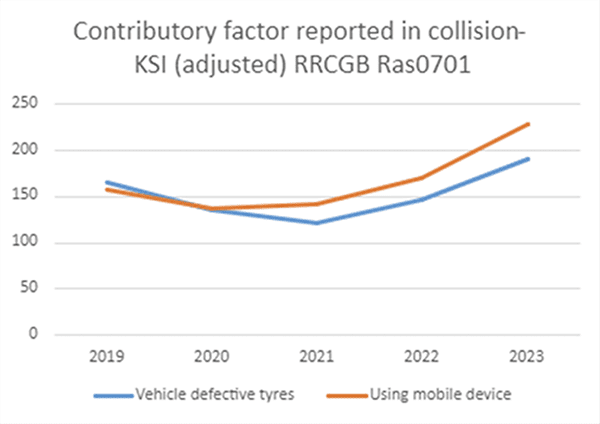
Urgent Action Needed to Address Growing Tyre Safety Crisis
The Department for Transport has released the latest “Reported Road Casualties Great Britain”, annual report for 2023. While there is a trend for a reduction in road casualties, the report details a concerning and significant increase in Killed or Seriously Injured (KSI) casualties linked to tyre-related incidents. The year-on-year increase highlights a growing problem on our roads, underscoring the urgent need for stronger action to address tyre safety.
The 2023 figures document a (29%) rise in KSI casualties compared to 2022 (from 147 to 190), the highest number of casualties due to tyre defects since 2018. This increase suggests that despite ongoing efforts, tyre safety remains a significant issue, and more needs to be done to prevent avoidable deaths and injuries. Shockingly, this figure is on par with mobile phone-related casualties.
TyreSafe is also campaigning for statistics to better reflect the causational factors contributing to those killed or injured, with underreporting posing an ongoing challenge in understanding the true scale of the problem, with police forces and road safety organisations inconsistent in attending incidents and reporting on tyre condition as a standard practice.
TyreSafe is calling for immediate and comprehensive measures to combat this escalating problem. The organisation’s latest Case for Action emphasises the critical need for increased awareness, stricter enforcement of existing regulations, and the adoption of new safety standards.
Stuart Lovatt, Chair of TyreSafe, stated, “These figures are a stark reminder that we cannot afford to be complacent when it comes to tyre safety. The increase in KSI numbers is deeply troubling and demonstrates that current efforts in both supporting road users to check their tyres, and reporting measures are not sufficient to reflect the scale of the issue, which we know from our own research is vast. We must act now to prevent further tragedies on our roads.
“The increase in tyre-related KSI’s is a call to action to raise the level of debate and understanding of the impact of dangerous and unroadworthy tyres. With the cost of living crisis continuing to hit the nation’s pockets hard, TyreSafe will continue to campaign to see drivers and riders understand how they can reduce their risks of an incident. Now is the time for Government to address this growing trend with more focus on tackling the rise in tyre related vehicle defects, focus on improving compliance levels in this area and launch a THINK! campaign to raise societal awareness of this dangerous trend.”
TyreSafe urges all road users to prioritise regular tyre checks, including tread depth, pressure, and overall condition, to ensure their vehicles are safe to drive. The charity also calls on the government to enhance tyre safety campaigns and consider implementing new regulations to address this growing concern.
TyreSafe continues to advocate for road users to take tyre safety seriously and to recognise the critical role that well-maintained tyres play in preventing incidents and saving lives. The charity uses the acronym ACT, to help motorists perform basic tyre checks and maintenance once a month and before long journeys:
Air pressure – The air pressure of each tyre should also be checked using an accurate gauge. Typically, car manufacturers recommend two different tyre pressures, one for light loads and another for when the vehicle is fully loaded. It’s essential that drivers adjust the pressures to accommodate the load they are carrying. These settings can be found in the vehicle handbook, on reputable internet tyre pressure charts such as the one at tyresafe.org, and often in the vehicle’s fuel filler cap or door sill.
Condition – with a visual check, looking at the overall condition of each tyre to see if anything might have penetrated the tread, such as nails or other objects. If any of these objects, cracks or bulges are present, the driver should seek professional advice immediately.
Tread – drivers should check the tread of their tyres to ensure they are above the UK legal tread depth minimum of 1.6mm. Ideally an accurate tread depth gauge should be used but if this is not available, a 20p coin can be used as a guide. Insert the 20p into the main sections of the tyre and at various points around the circumference – should you see the outer rim at any point, you need to have the tread depth checked as it may be illegal.
Source: Tyretradenews





























